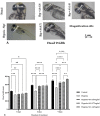Asiatic acid increased locomotor and head width by inducing brain-derived neurotrophic factor in intrauterine hypoxia-exposed zebrafish
- PMID: 38027402
- PMCID: PMC10658027
- DOI: 10.5455/OVJ.2023.v13.i10.12
Asiatic acid increased locomotor and head width by inducing brain-derived neurotrophic factor in intrauterine hypoxia-exposed zebrafish
Abstract
Background: Hypoxia ischemia leads to abnormal behavior and growth. Prenatal hypoxia also decreases brain adaptive potential, which can cause fatal effects such as cell death. Asiatic acid (AA) in Centella asiatica is a neuroprotector through antioxidant and anti-inflammatory activities.
Aim: This study aimed to analyze the effect of AA as a neuroprotector against hypoxia during intrauterine development on locomotor activity, head width, and brain-derived neurotrophic factor (BDNF) expression.
Methods: The true experimental laboratory research used a posttest control-only design. Zebrafish embryos (Danio rerio) aged 0-2 dpf (days postfertilization) were exposed to hypoxia with oxygen levels reaching 1.5 mg/l. Then, AA was administered at successive concentrations, namely, 0.36, 0.72, and 1.45 μg/ml, at 2 hpf (hours postfertilization), 3, 6, and 9 dpf. Head width, velocity activity, and BDNF expression were observed.
Results: Intrauterine hypoxia significantly decreased head width, velocity rate, and BDNF expression (<0.001). Administration of AA at all concentrations and age 9 dpf to zebrafish larvae with intrauterine hypoxia exposure increased head width ( p < 0.0001), velocity (p < 0.05), and relative mRNA expression of BDNF (p < 0.05).
Conclusion: AA is potentially neuroprotective to the brain in zebrafish larvae exposed to hypoxia during intrauterine development.
Keywords: Asiatic acid; BDNF; Growth; Hypoxia; Neuron.
Conflict of interest statement
The authors declare that there is no conflict of interest.
Figures



References
-
- Ariani A, Ghofar I, Khotimah H, Nurdiana N, Rahayu M. Asiatic acid in Centella asiatica extract towards morphological development in an intermittent hypoxia intrauterine embryo model and molecular prediction pathway of insulin-like growth factor-1 receptor signalling. Open. Vet. J. 2023;13:629–637. - PMC - PubMed
-
- Babenko O, Kovalchuk I, Metz G.A.S. Stress-induced perinatal and transgenerational epigenetic programming of brain development and mental health. Neurosci. Biobehav. Rev. 2015;48:70–91. - PubMed
-
- Borowiec B.G, Darcy K.L, Gillette D.M, Scott G.R. Distinct physiological strategies are used to cope with constant hypoxia and intermittent hypoxia in killifish (Fundulus heteroclitus) J. Exp. Biol. 2015;218:1198–1211. - PubMed
MeSH terms
Substances
LinkOut - more resources
Full Text Sources
